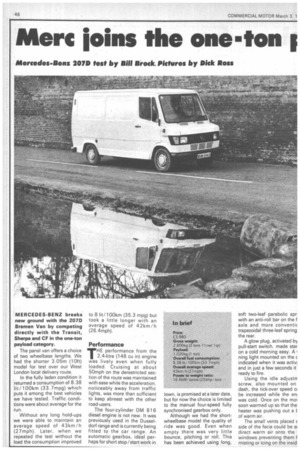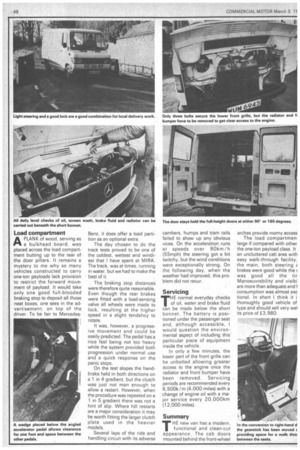Men joins the one-ton •
Page 48

Page 49

Page 50

If you've noticed an error in this article please click here to report it so we can fix it.
Mercedes-Benz 207D test by Bill Brock. Pictures by Dick Ross
MERCEDES-BENZ breaks new ground with the 2070 Bremen Van by competing directly with the Transit, Sherpa and CF in the one-ton payload category.
The panel van offers a choice of two wheelbase lengths. We had the shorter 3.05m (10ft) model for test over our West London local delivery route.
In the fully laden condition it returned a consumption of 8.38 lit/100km (33.7mpg) which puts it among the best vehicles we have tested. Traffic conditions were about average for the run.
Without any long hold-ups we were able to maintain an average speed of 43km / h (27rnph). Later, when we repeated the test without the load the consumption improved to 8 lit/100km (35.3 mpg) but took a little longer with an average speed of 42km /h (26.4mph).
Performance THE performance from the 2.4-litre (146 cu in) engine was lively even when fully loaded. Cruising at about 50mph on the derestricted section of the route was maintained with ease while the acceleration, noticeably away from traffic lights, was more than sufficient to keep abreast with the other road-users.
The four-cylinder OM 616 diesel engine is not new. It was previously used in the Dusseldorf range and is currently being fitted to the car range. An automatic gearbox, ideal perhaps for short stop /start work in town, is promised at a later date, but for now the choice is limited to the manual four-speed fully synchronised gearbox only.
Although we had the shortwheelbase model the quality of ride was good. Even when empty there was very little bounce, pitching or roll. This has been achieved using long, soft two-leaf parabolic spr with an anti-roil bar on the f axle and more conventic trapezoidal three-leaf spring the rear.
A glow plug, activated by pull-start switch, made star on a cold morning easy. A s ning light mounted on the c indicated when it was activ; and in just a few seconds it ready to fire.
Using the idle adjusta screw, also mounted on dash, the tick-over speed cc be increased while the eni was cold, Once on the mos soon warmed up so that the heater was pushing out a t of warm air.
The small vents placed c side of the facia could be s( direct warm air onto the windows preventing them f misting or icing on the insid.
1-cab environment
n ERCEDES-BENZ has continued a trend by proJing a good in-cab environnt. The driver's seat is ad;table fore and aft as well as • height and the back rest for (e.
The steering-wheel rim is 31r1 padded and has only two okes connecting it to the colin allowing a good view of a rly basic but well laid out in • ument panel with the speedo the centre, temperature uge on the left and fuel gauge the right, interspaced by ;ming lights for oil pressure, ov brake fluid, battery charge, )w plug and direction indica-s.
A wedge has been placed dow the accelerator pedal to ye clearance for the foot beJe the wheel arch. This also ows the foot controls to be laced at a convenient distance iart.
The seats are also spaced )art and in the conversion to jht-hand drive the gear stick is been moved to the right, Dse to the driving seat, making om for a walk through to the ar.
A high roof line and a low atform height combine with 3t, sides to provide a 7.34eu m 6 2cu ft) load compartment terrupted only by the flatpped wheel arches. At the rear e full height 1.5 5m (5ft) do1e doors can be opened from ithin to either 90 or 180' here they can be held by the or stays.
The lack of noise from both e engine and the body surrepiously added to the pleasure of • iving. The cowl to the rear of e engine proved a little cum)rsome to remove but while in ace effectively reduced engine )ise.
On occasions when the enne is neither underload nor on le overrun a high-pitched histle is emitted from the air ter and could become tedious • a long run. Body boom nor ally attributed to the flexing of le large side panels was linimised by a foam sandwich the outer side of the panel Ipports.
Load compartment APLANK of wood, serving as a bulkhead board, was placed across the load compartment butting up to the rear of the door pillars. It remains a mystery to me why so many vehicles constructed to carry one-ton payloads lack provision to restrict the forward movement of payload. It would take only one good full-blooded braking stop to deposit all those neat boxes, one sees in the advertisement, on top of the driver. To be fair to Mercedes
Benz, it does offer a load partition as an optional extra.
The day chosen to do the track tests proved to be one of the coldest, wettest and windiest that I have spent at MIRA. The track, was at times, running in water, but we had to make the best of it.
The braking stop distances were therefore quite reasonable. Even though the rear brakes were fitted with a load-sensing valve all wheels were made to lock, resulting at the higher speed in a slight tendency to rotate.
It was, however, a progressive movement and could be easily predicted. The pedal has a nice feel being not too heavy while the system provided both progression under normal use and a quick response on the panic stops.
On the test slopes the handbrake held in both directions on a 1 in 4 gradient, but the clutch was just not man enough to allow a restart. However, when the procedure was repeated on a 1 in 5 gradient there was not a hint of slip. Where hill restarts are a major consideration it may be worth fitting the larger clutch plate used in the heavier models.
Several laps of the ride and handling circuit with its adverse cambers, humps and tram rails failed to show up any obvious vices. On the acceleration runs at speeds over 90km / h (55mph) the steering got a bit twitchy, but the wind conditions were exceptionally strong. On the following day, when the weather had improved, this problem did not recur.
Servicing THE normal everyday checks of oil, water and brake fluid can be made below the short bonnet. The battery is positioned under the passenger seat and, although accessible, I would question the environmental aspect of including this particular piece of equipment inside the vehicle.
In only a few minutes, the lower part of the front grille can be unbolted allowing greater access to the engine once the radiator and front bumper have been removed. Servicing periods are recommended every 6,500k /m (4,000 miles) with a change of engine oil with a maOr service every 20,000km (I 2,000 miles).
Summary THE new van has a modern, functional and clean-cut appearance. The cab doors mounted behind the front-wheel
arches provide roomy access The load compartmen large if compared with other the one-ton payload class. It an uncluttered cab area with easy walk-through facility. the main, both steering z brakes were good while the was good all the tir Manoeuvrability and visibi are more than adequate and 1 consumption was almost exc tional. In short I think it i thoroughly good vehicle of type and should sell very wel its price of £3,980.
































































































































































